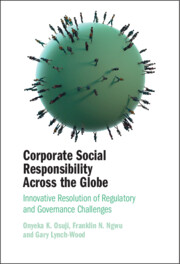 Corporate Social Responsibility Across the Globe
Corporate Social Responsibility Across the Globe Book contents
- Corporate Social Responsibility Across the Globe
- Corporate Social Responsibility Across the Globe
- Copyright page
- Epigraph
- Contents
- Figures
- Table of Cases
- Table of Legislation
- 1 Introduction: The Centrality of Regulation in Corporate Responsibility
- Part I Regulation Concepts, Paradigms and Approaches for Corporate Social Responsibility
- 2 The Values System Paradigm As a Regulatory Alternative to Stakeholder Needs CSR
- 3 Incentives, Public Procurement and Market Mechanisms
- 4 Governance of Firms, Poverty and Shared Responsibilities for Human Rights in UNGPs: Smart-Mix Regulation and CSR within Coalitions of the (Un)Willing
- Part II Infusing Corporate Social Responsibility in Corporate Governance
- Part III Stimulating Private Regulation of Corporate Social Responsibility
- References
2 - The Values System Paradigm As a Regulatory Alternative to Stakeholder Needs CSR
from Part I - Regulation Concepts, Paradigms and Approaches for Corporate Social Responsibility
Published online by Cambridge University Press: 15 June 2023
- Corporate Social Responsibility Across the Globe
- Corporate Social Responsibility Across the Globe
- Copyright page
- Epigraph
- Contents
- Figures
- Table of Cases
- Table of Legislation
- 1 Introduction: The Centrality of Regulation in Corporate Responsibility
- Part I Regulation Concepts, Paradigms and Approaches for Corporate Social Responsibility
- 2 The Values System Paradigm As a Regulatory Alternative to Stakeholder Needs CSR
- 3 Incentives, Public Procurement and Market Mechanisms
- 4 Governance of Firms, Poverty and Shared Responsibilities for Human Rights in UNGPs: Smart-Mix Regulation and CSR within Coalitions of the (Un)Willing
- Part II Infusing Corporate Social Responsibility in Corporate Governance
- Part III Stimulating Private Regulation of Corporate Social Responsibility
- References
Summary
This chapter argues that ‘stakeholder needs’ and the ‘value system paradigm’ are alternative approaches to regulating corporate social responsibility (CSR). Drawing on Pound’s Theory of Social Interests and the institutional and stakeholder theories, it highlights the importance of contextualism in CSR and demonstrates that a values system paradigm may be a more suitable regulatory strategy, particularly in the developing and emerging markets. The chapter suggests that the stakeholder needs approach should be coupled with a values system paradigm for a more effective CSR when stakeholder responsiveness is desired.
Keywords
- Type
- Chapter
- Information
- Corporate Social Responsibility Across the GlobeInnovative Resolution of Regulatory and Governance Challenges, pp. 11 - 38Publisher: Cambridge University PressPrint publication year: 2023
